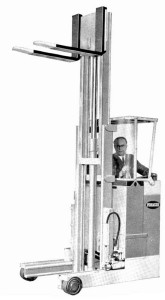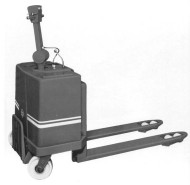 Warehouse & Logistics News is proud to bring you the fifty second instalment in our exclusive series on the history of the fork lift truck, the machine that over the decades has revolutionised the face of materials handling around the world. Our series has now reached its half-century in terms of the episodes we’ve published so far, so we’re celebrating reaching a major milestone. And there’s still plenty of the story to come.
Warehouse & Logistics News is proud to bring you the fifty second instalment in our exclusive series on the history of the fork lift truck, the machine that over the decades has revolutionised the face of materials handling around the world. Our series has now reached its half-century in terms of the episodes we’ve published so far, so we’re celebrating reaching a major milestone. And there’s still plenty of the story to come.
Our writer is James Brindley, an acknowledged authority on fork lift trucks. James’s distinguished career has involved engineering and management roles with BT Rolatruc and serving as a Director of the Fork Lift Truck Association, before he set up the National Fork Truck Heritage Centre in 2004 as Britain’s first such collection open to the public.
The Heritage Centre continues to need your support in 2011, and if you or your company would like to help in any way, you can contact James on the number below. Now sit back and enjoy the latest part of this fascinating series.
Episode 52: 1966 continued – Economic growth lifts global fork truck market
Amongst the larger forklift manufacturers, 1966 was another year for expansion and innovation, and forklift companies around the world seemed to be enjoying a more relaxed economic atmosphere. For their part the Hyster Company opened a new technical centre in Portland, which was claimed to be the worlds largest and best equipped lift truck testing facility. They also replaced the forklift models S30B, S40B and S50B with three other models designated S30C, S40C and S50C respectively. In addition, to tidy up the number of models in production, the RC 100 from the Pioneer range was discontinued.
Continuing with interests in the USA, the Raymond Company opened a new factory site in Brantford Ontario and following the trend of its competitors began to introduce integrated wire guidance systems onto some of their order picker models. The Crown Company of New Bremen, Ohio, USA chose expansion over new models and moved some of its operations into Australia, where it began to produce their already successful range of “H” and “B” model pallet trucks and the “W” series Walkie stacker trucks.
Some European companies also experienced degrees of business success, and BT Industries of Sweden added a new powered pallet truck to its range. The LT 20A had a lifting capacity of two tons and was fitted with a pedestrian stand–on platform for use on the longer warehouse runs. To complete this list of overseas successes, Sichelschmidt of Germany produced their first explosion protected forklift truck.
Back in the UK, Lansing Bagnall discontinued the models FOER 7 and 8 and launched their counterbalance model FOER 9 to replace them: this model was eventually to be produced with a lifting capacity range from 1,500 lbs to 10,000 lbs. Also, the company introduced electronic control into the design of their new stand-on pallet and stillage trucks. These machines were designated as model P/SOES 4, and had lifting capacities from 2,240 lbs to 4,000 lbs.
 At the recent Earls Court Exhibition, in May last year, the new Stacatruc range of battery-powered forklifts was exhibited alongside the Clarklift gas and diesel models. These were rated to lift from 4,500lbs to 7,000lbs. Fatigue free controls and ergonomic seating arrangements were claimed to provide the operator with all the comfort that was necessary to give a maximum operating performance. This, together with its latest electrical system, allowed the truck to achieve faster traction and lifting speeds.
At the recent Earls Court Exhibition, in May last year, the new Stacatruc range of battery-powered forklifts was exhibited alongside the Clarklift gas and diesel models. These were rated to lift from 4,500lbs to 7,000lbs. Fatigue free controls and ergonomic seating arrangements were claimed to provide the operator with all the comfort that was necessary to give a maximum operating performance. This, together with its latest electrical system, allowed the truck to achieve faster traction and lifting speeds.
Another forklift that was launched at the Exhibition was a new reach truck from Hirst and Sons. The Forager “Reacher 25” was equipped with transistorised control and could lift loads up to 2,500lb capacity. It could also work in aisles as small as 6 feet four inches wide, and was available with a tilting or non-tilting mast.
In response to the military market, this was also the year when Lancer Boss redesigned the rough terrain forklift. Radically different from those launched, by the competition within the last two years was their machine developed with the help of the Military Experimental Engineering Establishment in Hampshire. The main features were a retractable mast and a long wheelbase, which cut out the need for a counterweight. This design was achieved without losing any substantial stability or tractive performance across terrains as diverse as marsh, mountain and desert.
To be continued
By James Brindley, Director, National Fork Truck Heritage Centre.




Comments are closed.